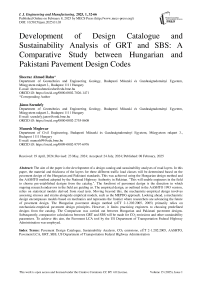Development of Design Catalogue and Sustainability Analysis of GRT and SBS: A Comparative Study between Hungarian and Pakistani Pavement Design Codes
Автор: Sheeraz Ahmed Rahu, János Szendefy, Munesh Meghwar
Журнал: International Journal of Engineering and Manufacturing @ijem
Статья в выпуске: 1 vol.15, 2025 года.
Бесплатный доступ
The aim of the paper is the development of a design catalog and sustainability analyses of road layers. In this paper, the material and thickness of the layers for three different traffic load classes will be determined based on the pavement design of the Hungarian and Pakistani standards. This was achieved using the Hungarian design method and the AASHTO method adopted by the National Highway Authority in Pakistan. "This will enable engineers in the field to choose pre-established designs from the catalog.". The forefront of pavement design is the direction in which ongoing research endeavors in the field are guiding us. The empirical design, as outlined in the AASHTO 1993 version, relies on statistical models derived from road tests. Moving beyond this, the mechanistic-empirical design involves assessing stresses and strains alongside empirical models, such as the MEPDG approach. Looking ahead, a mechanistic design encompasses models based on mechanics and represents the frontier where researchers are advancing the future of pavement design. The Hungarian pavement design method (eÚT 2-1.202:2005, 2005) primarily relies on mechanistic-empirical pavement design principles. However, it limits practicing engineers to choosing predefined designs from the catalog. The Comparison was carried out between Hungarian and Pakistani pavement designs. Subsequently, comparative calculations between GRT and SBS will be made for CO2 emissions and other sustainability parameters. To achieve this aim, the Pavement LCA tool by the US Department of Transportation Federal Highway Administration was employed.
Pavement Design Catalogue, Sustainability Analysis, CO2 emissions, eÚT 2-1.202:2005, AASHTO, Pavement LCA, GRT, SBS, US Department of Transportation Federal Highway Administration
Короткий адрес: https://sciup.org/15019642
IDR: 15019642 | DOI: 10.5815/ijem.2025.01.03
Список литературы Development of Design Catalogue and Sustainability Analysis of GRT and SBS: A Comparative Study between Hungarian and Pakistani Pavement Design Codes
- C. M. F. Hafifi Che Wahid et al., “Carbon footprints calculator of highway pavement rehabilitation: The quantification of carbon emissions per unit activity,” in IOP Conference Series: Materials Science and Engineering, Institute of Physics Publishing, Apr. 2019. doi: 10.1088/1757-899X/512/1/012010.
- R. Nádasi and C. Tóth, “Towards green rating systems in hungarian road design,” Pollack Periodica, vol. 14, no. 2, pp. 61–72, 2019, doi: 10.1556/606.2019.14.2.6.
- M. Marzouk, M. El-zayat, and A. Aboushady, “Assessing environmental impact indicators in road construction projects in developing countries,” Sustainability (Switzerland), vol. 9, no. 5, May 2017, doi: 10.3390/su9050843.
- P. Pereira and J. Pais, “Main flexible pavement and mix design methods in Europe and challenges for the development of an European method,” Journal of Traffic and Transportation Engineering (English Edition), vol. 4, Oct. 2017, doi: 10.1016/j.jtte.2017.06.001.
- C. Tóth and P. Primusz, “New Hungarian mechanistic-empirical design procedure for asphalt pavements,” Baltic Journal of Road and Bridge Engineering, vol. 15, no. 1, pp. 161–186, 2020, doi: 10.7250/bjrbe.2020-15.466.
- T. F. . Fwa, The handbook of highway engineering. Taylor & Francis, 2006.
- “András Gulyás, Csaba Tóth Road Pavement Structures For Infrastructure Civil Engineering Bsc Program Road Pavement And Railway Track Structures.”
- “Traffic_and_Highway_Engineering_Enhanced”.
- A. Behnood and J. Olek, “Rheological properties of asphalt binders modified with styrene-butadiene-styrene (SBS), ground tire rubber (GTR), or polyphosphoric acid (PPA),” Constr Build Mater, vol. 151, pp. 464–478, 2017, doi: https://doi.org/10.1016/j.conbuildmat.2017.06.115.
- M. Taciroglu, “Comparison of elvaloy and styrene-butadiene-styrene added polymer modified bitumen,” Journal of Innovative Transportation, vol. 4, Oct. 2023, doi: 10.53635/jit.1312225.
- H. Jahanbakhsh, M. M. Karimi, H. Naseri, and F. M. Nejad, “Sustainable asphalt concrete containing high reclaimed asphalt pavements and recycling agents: Performance assessment, cost analysis, and environmental impact,” J Clean Prod, vol. 244, p. 118837, 2020, doi: https://doi.org/10.1016/j.jclepro.2019.118837.
- W. S. Alaloul, M. Altaf, M. A. Musarat, M. F. Javed, and A. Mosavi, “Systematic review of life cycle assessment and life cycle cost analysis for pavement and a case study,” Apr. 02, 2021, MDPI AG. doi: 10.3390/su13084377.
- W. Alaloul, M. Altaf, M. Ali Musarat, W. Salah Alaloul, M. Faisal Javeed, and A. Mo-savi, “Life Cycle Assessment and Life Cycle Cost Analysis in Infrastructure Projects: A Systematic Review Predictive-Decision Models: Predictable Decision-Making View project Cryptanalysis and Authentication for Smart Grids View project Life Cycle Assessment and Life Cycle Cost Analysis in Infra-structure Projects: A Systematic Review,” 2021, doi: 10.20944/preprints202103.0316.v1.
- “Mechanistic Empirical Pavement Design Guide.”
- M. S. Siverio Lima, C. Makoundou, C. Sangiorgi, and F. Gschösser, “Life Cycle Assessment of Innovative Asphalt Mixtures Made with Crumb Rubber for Impact-Absorbing Pavements,” Sustainability, vol. 14, no. 22, 2022, doi: 10.3390/su142214798.


